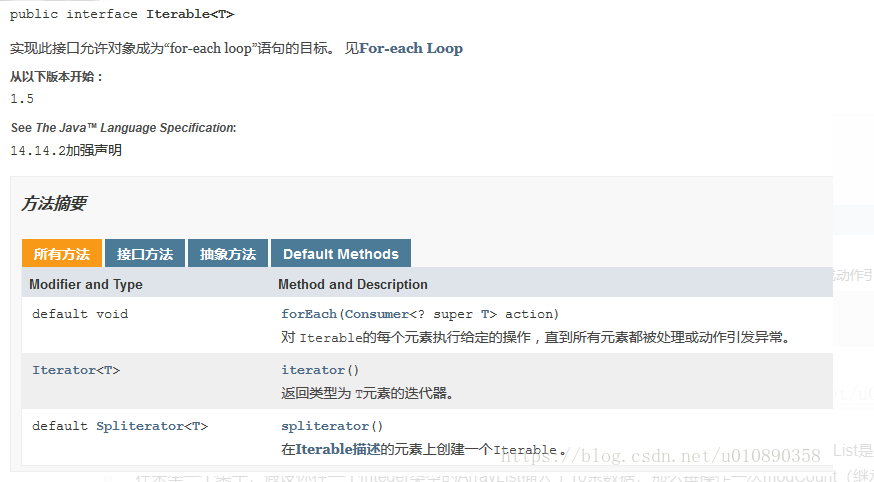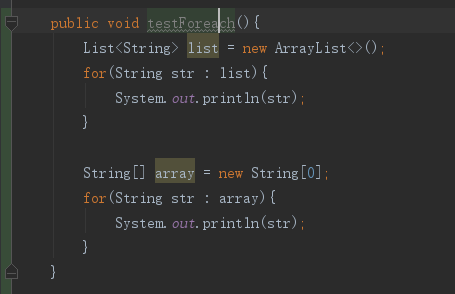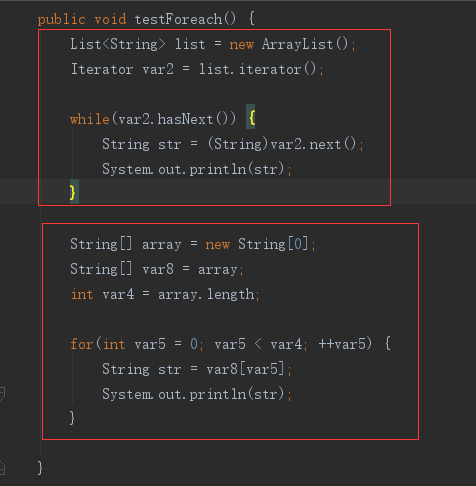前言:最近看 java 集合方面的源码,了解到集合使用了 fail-fast 的机制,这里就记录一下这个机制是什么,有什么用,如何实现的。
一、fail-fast 简介
fail-fast 机制,即快速失败机制,是java集合(Collection)中的一种错误检测机制。当在迭代集合的过程中该集合在结构上发生改变的时候,就有可能会发生 fail-fast,即抛出 ConcurrentModificationException 异常。fail-fast 机制并不保证在不同步的修改下一定会抛出异常,它只是尽最大努力去抛出,所以这种机制一般仅用于检测 bug。
fail-fast 机制出现在 java 集合的 ArrayList、HashMap 等,在多线程或者单线程里面都有可能出现快速报错,即出现 ConcurrentModificationException 异常。
二、fail-fast 有什么用?
为了检测在迭代集合的过程中,这个集合是否发生了增加、删除等(add、remove、clear)使结构发生变化的事。
三、测试
这个单测跑下来是成功的,下面有讲解为什么。
import org.junit.Assert; import org.junit.Before; import org.junit.Test; import java.util.ArrayList; import java.util.ConcurrentModificationException; import java.util.Iterator; import java.util.List; /** * @author yule * @date 2018/9/13 17:05 */ public class ArrayListTest { private List<Integer> list = null; @Before public void buildList(){ list = new ArrayList<>(); for(int i = 0; i < 10; i++){ list.add(i); } Assert.assertEquals("[0, 1, 2, 3, 4, 5, 6, 7, 8, 9]", list.toString()); } @Test public void testFor(){ for(int i = 0; i < list.size(); i++){ if(i == 2){ //这个会删除成功,这里没有 fail-fast 的机制 list.remove(2); } } Assert.assertEquals("[0, 1, 3, 4, 5, 6, 7, 8, 9]", list.toString()); } @Test(expected = ConcurrentModificationException.class) public void testForEach(){ for(int x : list){ if(x == 2){ //这个抛出异常,这里就是 fail-fast 的机制,毕竟 foreach 底层就是 Iterator list.remove(2); } } } @Test(expected = ConcurrentModificationException.class) public void testIterator(){ Iterator<Integer> iterator = list.iterator(); while (iterator.hasNext()){ int x = iterator.next(); if(x == 2){ //这个抛出异常,这里就是 fail-fast 的机制 list.remove(2); } } } @Test public void testIteratorSuccess(){ Iterator<Integer> iterator = list.iterator(); while (iterator.hasNext()){ int x = iterator.next(); if(x == 2){ //这个会成功,不会抛出异常,这里也是 fail-fast 的机制,不知道这里为什么会成功,可以继续看下去 iterator.remove(); } } Assert.assertEquals("[0, 1, 3, 4, 5, 6, 7, 8, 9]", list.toString()); } }
第一个 testFor() 单测成功,是因为普通的 for 循环没有 fail-fast 机制,因为 fail-fast 机制只针对迭代集合的过程。
第二个 testForEach() 单测抛异常,是因为 forEach 底层就是使用了迭代器,其原因和 testIterator() 单测一致。
第三个 testIterator() 单测抛异常,是因为 ArrayList.remove() 方法只修改了 modCount++,而没有修改 Itr 的 expectedModCount。(详见下面原理)
第四个 testIteratorSuccess() 单测成功,是因为 ArrayList 的迭代器的 remove() 方法不仅仅是修改了 modCount,也修改了 Itr 的 expectedModCount。(详见下面原理)
四、fail-fast 在源码中(ArrayList)如何实现的?(原理)
首先,必须了解 fail-fast 两个关键的东西,ArrayList 的 modCount 和 ArrayList.Itr 内部类的 expectedModCount。
其中,modCount 是抽象类 AbstractList 中的变量,默认为 0,而 ArrayList 继承了 AbstractList ,所以也有这个变量,modCount 用于记录集合操作过程中作的修改次数,并不是 size。每次 add 或者 remove modCount 都会 ++。
其中,expectedModCount 是 ArrayList 内部类 Itr 的成员变量,初始值为 modCount。执行迭代器的 remove、add 方法,都会先执行 ArrayList 的 remove、add 方法(modCount++),然后会执行 expectedModCount = modCount。
上面说到 fail-fast 只针对 迭代器,所以需要知道 ArrayList 的迭代器的实现源码:
/** * Returns an iterator over the elements in this list in proper sequence. * * <p>The returned iterator is <a href="#fail-fast"><i>fail-fast</i></a>. * * @return an iterator over the elements in this list in proper sequence */ public Iterator<E> iterator() { return new Itr(); }
ArrayList 的 内部类 Itr 实现了 Iterator 接口,源码如下:
/** * An optimized version of AbstractList.Itr */ private class Itr implements Iterator<E> { // 指集合遍历过程中的即将遍历的元素的索引 int cursor; // index of next element to return int lastRet = -1; // index of last element returned; -1 if no such // 这个就是 fail-fast 判断的关键变量,初始值就为ArrayList中的modCount int expectedModCount = modCount; public boolean hasNext() { return cursor != size; } @SuppressWarnings("unchecked") public E next() { checkForComodification(); int i = cursor; if (i >= size) throw new NoSuchElementException(); Object[] elementData = ArrayList.this.elementData; if (i >= elementData.length) throw new ConcurrentModificationException(); cursor = i + 1; return (E) elementData[lastRet = i]; } public void remove() { if (lastRet < 0) throw new IllegalStateException(); checkForComodification(); try { ArrayList.this.remove(lastRet); cursor = lastRet; lastRet = -1; expectedModCount = modCount; } catch (IndexOutOfBoundsException ex) { throw new ConcurrentModificationException(); } } @Override @SuppressWarnings("unchecked") public void forEachRemaining(Consumer<? super E> consumer) { Objects.requireNonNull(consumer); final int size = ArrayList.this.size; int i = cursor; if (i >= size) { return; } final Object[] elementData = ArrayList.this.elementData; if (i >= elementData.length) { throw new ConcurrentModificationException(); } while (i != size && modCount == expectedModCount) { consumer.accept((E) elementData[i++]); } // update once at end of iteration to reduce heap write traffic cursor = i; lastRet = i - 1; checkForComodification(); } final void checkForComodification() { if (modCount != expectedModCount) throw new ConcurrentModificationException(); } }
其中,cursor 是指集合遍历过程中的即将遍历的元素的索引。
lastRet 是 cursor - 1,默认为 -1,即不存在上一个时,为 -1,它主要用于记录刚刚遍历过的元素的索引。
迭代器迭代结束的标志就是 hasNext() 返回 false,而该方法就是用 cursor 游标和 size (集合中的元素数目)进行对比,当 cursor 等于 size 时,表示已经遍历完成。
五、解惑
1、什么是指集合在结构上发生变化呢?
其实就是指 size 有变动,比如 ArrayList 的 add 和 delete、clear。
2、迭代集合的过程又是指什么呢?(这里涉及到 forEach 的原理)
迭代集合的过程指的就是使用代迭代器 Iterator 或者 forEach 语法,实际上一个类要使用 forEach 就必须实现 Iterable 接口并且重写它的 Iterator 方法所以 forEach 在本质上还是使用的 Iterator。因为 forEach 原理:在编译的时候编译器会自动将对 for 这个关键字的使用转化为对目标的迭代器的使用。

所以得出结论:
1、ArrayList 之所以能使用 foreach 循环遍历,是因为 ArrayList 所有的 List 都是 Collection 的子接口,而 Collection 是 Iterable 的子接口,ArrayList 的父类 AbstractList 正确地实现了 Iterable 接口的 iterator 方法。
2、任何一个集合,无论是 JDK 提供的还是自己写的,只要想使用 foreach 循环遍历,就必须正确地实现 Iterable 接口
实际上,这种做法就是23中设计模式中的迭代器模式。
3、那么又有一个问题:数组并没有实现 Iterable 接口啊,为什么数组也可以用 foreach 循环遍历呢?
其实:Java 将对于数组的 foreach 循环转换为对于这个数组每一个的循环引用。
所以结论为:编译器对集合的 forEach 会调用集合的 迭代器;对数组的 forEach 会调用数组的 for 循环。
测试:java文件

编译后:class 文件

参考:https://blog.csdn.net/zymx14/article/details/78394464